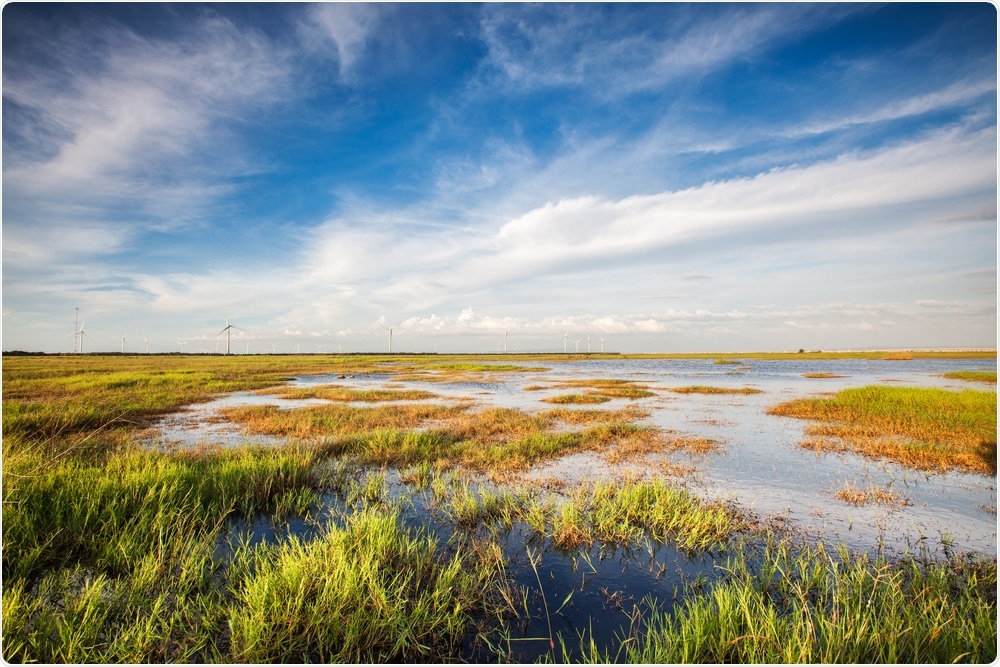Implementing large-scale wetlands in the areas surrounding agricultural systems could limit agricultural runoff in key waterways.

Wetlands. Image Credit: higrace/Shutterstock.com
Larger scale and more cost-effective measures for mitigating agricultural runoff
Agricultural runoff poses a significant risk for ecosystems and the organisms they incorporate. This risk is particularly of concern in areas surrounding agricultural areas. As such, researchers and stakeholders have attempted to develop the most effective strategies to reduce the extent and severity of runoff.
A new study led by Amy Hansen, an assistant professor of civil, environmental & architectural engineering at the University of Kansas, USA, shows that wetlands constructed along waterways are the most cost-effective way to reduce nitrate and sediment loads in large streams and rivers.
The study, published in the journal of Proceedings of the National Academy of Sciences, considers preventative approaches and conservation efforts using wetlands at the watershed scale and not at a smaller, individual farm, scale.
Watersheds are an entire region that drains into a common waterway and are an important source of ecosystem services serving as fisheries and recreational areas.
Excessive nitrate or sediment affect local fish populations, the amount of money we have to spend to treat drinking water, and there's a downstream effect also. Our rivers integrate what's happening across the landscape, so that location that you love to go and fish or swim -- whether that continues to be a great place to fish or swim has a lot to do with the choices that people are making further upstream.
Excess pollution goes to a water body downstream like a reservoir or the ocean and causes algal blooms or hypoxic or 'dead zones.' The dead zone in the northern Gulf of Mexico is directly correlated with nitrate that comes from the Mississippi River Basin."
Researchers designed a series of computational models of the Le Sueur River Basin in southern Minnesota, a watershed subject to runoff from intense agricultural production of corn and soybeans characteristic of the entire Upper Midwest region.
The models were developed to compare approaches aiming to improve water quality, including reducing runoff from farms and adding wetlands. The economic costs associated with each approach was then considered. However, most methods conserved are based on voluntary participation by individual farms and farmers, and are therefore implemented by a variety of different agencies and are discontinuous in space and time, making them less effective.
Prof. Hansen describes; "Currently, there's individual management or conservation practices, and those include cover crop, high-precision fertilizer application, reduced tillage, constructed wetlands and ravine tip management. Those are some of the different practices we considered," adding that, "But management of non-point sources is voluntary in the U.S. through incentive programs, and the scale these conservation practices are often considered at is the individual farmer when a coordinated approach is much more effective. In a way, it's like a recycling program where you're saying, 'Anyone recycling one thing is better than no one recycling. 'This is true, some recycling is better than no recycling, but a coordinated approach will save money and be more effective."
Wetland construction provides the most affordable and successful approach
The computational models demonstrated that wetlands offer both the best results and are most effective. Benefits are also greater when the size and location are at the scale of a watershed.
Researchers described that wetlands are particularly successful at slowing down water as it heads toward streams and rivers and contains vegetation and microbes that can process nutrients used as fertilizer on crops.
"Microbes and plants within wetlands are actually removing the nitrate from the water," Hansen said. "With sediment, on the other hand, what the fluvial wetlands are doing is holding water back during these high flows -- and by holding that water back you're getting lower peak stream flows, which is reducing the amount of near channel sediment that's being transported downstream."
The collaborative research effort provided interdisciplinary knowledge, considering insights into how waterways improve water quality as well as their associated economic costs for agriculture. The latter is a key feature of the new study, as the economics of implementing new approaches are often not considered in research efforts.
However, the economic burden of potential changes for stakeholders is a key factor to examine when determining the most beneficial approaches.
According to the research team, measures such as integrating wetland areas "were clearly more cost-effective than field management." Nonetheless, the researchers found the performance of wetlands required optimal placement, and often cost-effective wetlands can be too expensive for a single farm or one agency to implement.
This work shows that we can't make real progress toward our goals for improving water quality in agricultural areas with more of a business-as-usual approach," adding that, "Instead, conservation actions, and the investments that support them, can be more effective if they consider the interactions that underlie the source of water pollution and how different management options influence them.”
Co-author Jacques Finlay
The present study provides a fundamental proof-of-concept that future studies can expand on. Although further research is required in other regional areas, the findings provide valuable insight into the methods to mitigate the negative impacts of agricultural systems.